Old Town, Chicago
|
Old Town Triangle Historic District | |
|
Old Town sign, on Wells and North Avenues. An identical sign exists on Wells and Division streets. | |
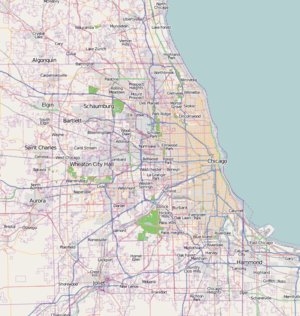   | |
| Location | Chicago, Illinois |
|---|---|
| Built | 1872 |
| Architect | Multiple |
| Architectural style | Italianate, Queen Anne, Other |
| NRHP Reference # | 84000347 [1] |
| Significant dates | |
| Added to NRHP | November 8, 1984 |
| Designated CL | September 28, 1977 |
Old Town is a neighborhood and historic district in North Side, Chicago, Illinois home to many of Chicago's older, Victorian-era buildings. Examples include St. Michael's Church, one of seven buildings to survive the Great Chicago Fire.
Location and name of Old Town

In the 19th century, German immigrants moved to the meadows north of North avenue and began farming previous swampland, planting celery, potatoes and cabbages. This gave the area the nickname 'The Cabbage Patch'.[4][5] The name stuck until around 1900.[4]
During World War II, the streets of North, Clark, and Ogden Avenues (which form a triangle) were designated a 'neighborhood defense unit' by Chicago's Civil Defense Agency. In the years immediately after the war, The population of “North Town” (as it was known) sponsored annual art fairs called the “Old Town Holiday.” The art fairs were popular attractions to the neighborhood[6] and the name "Old Town" was used in the title of the Old Town Triangle Association when it was formed in 1948, by residents who wanted to improve the condition of buildings that were suffering from physical deterioration.[5][7] In the 1950s, much of Old Town was an enclave to many of the first Puerto Ricans to emigrate to Chicago. They referred to this area as part of "La Clark".
There is no legal entity known as Old Town, although claims have been made as to the nature of its unspecific borders:
It is important to stress that there is no such legal entity as Old Town. Old Town is where you make it.— Richard Atcheson, Holiday Magazine March 1967[8]
This neighborhood is supposed to be as much a sound as a place, and it's from the bells of St. Michael's Church. The story goes you only really live in Old Town if you can hear them.— Alan G. Artner, Chicago Tribune, March 29, 2008 [2]
...it was said that all who lived within hearing distance of the church's bells were Old Towners.— Donna Gill, Chicago Tribune, December 4, 1967[3]
History of Old Town
Early history




The land known as Old Town originally served as a home and trade center to many Nations including Potawatomi, Miami and Illinois.[9] Following the Treaty of Chicago in 1833, most of the indigenous people were forcibly removed, and the land was then settled in the 1850s by German-Catholic immigrants. Clark Street is a leftover of the culture, it being an old road which followed a slight ridge along Lake Michigan.
Old Town is home to many of Chicago's older, Victorian-era buildings. The neighborhood is also home to St. Michael's Church, originally a Bavarian-built church, and one of 7 to survive the path of the Great Chicago Fire.[10] Many of the streets and alleys, particularly in the Old Town Triangle section, predate the Great Chicago Fire and do not all adhere to a typical Chicago grid pattern.
Old Town has one Brown-Purple Line 'L' station at 1536-40 North Sedgwick Street. It is one of the oldest standing stations on the 'L', built in 1900.

The first homophile organization in American history, the Society for Human Rights, was established by Henry Gerber at his home, the Henry Gerber House, on North Crilly Court in 1924. The Henry Gerber House was designated a Chicago Landmark on June 6, 2001.[11] In June 2015 it was named a National Historic Landmark.[12]
In 1927, sculptors Sol Kogen and Edgar Miller purchased and subsequently rehabilitated a house on Burton Place, near Wells Street, into the Carl Street Studios. Through the 1930s, an art colony emerged in the neighborhood as artists moved from the Towertown neighborhood near Washington Square Park.
1950s - 1969
In 1955, upon the first election of Mayor Daley, 43rd ward alderman Paddy Bauler who kept a saloon on North and Sedgwick Avenue called De Luxe Gardens[13][14][15][16][17] in Old Town famously declared "Chicago ain't ready for reform yet" many times over in his bar while dancing a jig.[18]
During the 1960s the neighborhood was the center of the yippie and hippie counter culture in the midwestern United States. This was mostly because by the 1950s and 1960s many of the original families that had settled in the neighborhood had moved to the suburbs during white flight, leaving older, Victorian buildings with storefronts available to rent for cheap. This dense storefront-laden area (Wells & North Ave.) became the nexus of hippie culture, (as well as the newly emerging out-homosexual culture) and gave rise to the boutiques (Crate & Barrel, for example) in the neighborhood today. Seed Magazine was a literary staple of the neighborhood at the time.
There is a little piece of Chicago Real Estate, west of Lincoln Park, that is the pride of urban conservationists and the despair of bulldozers. It is a community widely known as Old Town...Old Town is full of conflict, full of life; a sometimes maddening but always exciting place to live.— Richard Atcheson, Holiday Magazine March 1967[8]

The violent events that took place during the 1968 Democratic National Convention transpired around the convention center, Grant Park, Old Town, and Lincoln Park, adjacent to Old Town.[19]
I pointed out that it was in the best interests of the City to have us in Lincoln Park ten miles away from the Convention hall. I said we had no intention of marching on the Convention hall, that I didn't particularly think that politics in America could be changed by marches and rallies, that what we were presenting was an alternative life style, and we hoped that people of Chicago would come up, and mingle in Lincoln Park and see what we were about.
The film The Weather Underground has a scene on La Salle Avenue in Old Town, which describes the Zeitgeist of the era.
Old Town was home to many gays & lesbians from the 1960s through the 1980s. There were numerous gay bars lining Wells Street (all of them closed as of 2013). This was the first "gay ghetto" in Chicago, predating the current Lake View neighborhood (which is the current epicenter of gay life); As the area gentrified, the gays moved further north to Lincoln Park and then Lake View neighborhoods.
During the 1960s and 1970s Old Town became the center of Chicago folk music, which was experiencing a revival at the time. In 1957, the Old Town School of Folk Music opened at 333 West North Avenue and stayed at that address until 1968 when the school moved to 909 West Armitage Avenue.[21] It has retained the name, although it is no longer located within Old Town. Singer-songwriters such as Bob Gibson, Steve Goodman, Bonnie Koloc, and John Prine played at several clubs on Wells Street, such as The Earl of Old Town.[22][23] The Old Town School of Folk Music was closely associated with these artists and clubs. The largest and most successful of the folk clubs was Mother Blues, which featured nationally known artists and groups such as Spanky and Our Gang, Jose Feliciano, Odetta, Oscar Brown, Jr, Bob Gibson, Josh White, and Chad Mitchell. It also presented comedian George Carlin, Sergio Mendez, Brazil '66, and The Jefferson Airplane.
A few of the institutions from the 1960s era still exist today, such as The Second City, the Old Town Ale House, Bijou Video, the Old Town School of Folk Music (which moved after the 1968 riots), the Up Down Tobacco Shop (which used to be located just south of its current location), and the Old Town Aquarium.
1970s until today

After the Martin Luther King assassination, and the subsequent riots, the neighborhood experienced a tense racial division during the 1970s and 1980s which left a segregation between Old Town north of North Ave. and Old Town south of North Ave. In the early 2000s this trend has begun to shift towards a gentrification of the area south of North Ave. on Sedgwick, Blackhawk, Hudson and Mohawk streets, near the Marshall Field Garden Apartments. The area to the west of these streets, near the North and Clybourn Red Line stop has been dubbed "SoNo" by real estate developers. SoNo's boundaries are North Avenue, Halsted Street, Division Street and the North Branch of the Chicago River. Currently, Old Town south of North Avenue is a mixture of rich and poor, though is steadily gentrifying.[24] The demolition of the Cabrini–Green high rise housing projects to the south has led to significant demographic changes in the neighborhood. The original Francis X. Cabrini Row Houses still are standing. The Parkside of Old Town development was built replacing the Cabrini-Green high rises just south of Old Town.
By 1976, Wells Street in Old Town had many sex-industry businesses operating,[25] so many that Wells street was specifically named in Time Magazine's 1976 article "The Porno Plague".[26] It was thought that some of the businesses had mob connections.[27]
Current cultural amenities in the neighborbood include Old Town Triangle Art Center,[28] and the annual Old Town Art Fair.
Gallery
 Entrance to the Second City (photographed in 2015). Note the architectural details that had been repurposed into the current structure
Entrance to the Second City (photographed in 2015). Note the architectural details that had been repurposed into the current structure This is an 1875 carriage house in the area that was renovated in the style of the 1960s.[29] (photographed in 2014)
This is an 1875 carriage house in the area that was renovated in the style of the 1960s.[29] (photographed in 2014)

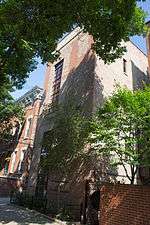
 Buildings in Old Town in 2015
Buildings in Old Town in 2015 Exterior wall on an Old Town residence in 2015
Exterior wall on an Old Town residence in 2015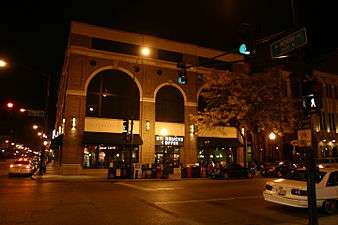 The intersection of North Ave. and Wells in 2006
The intersection of North Ave. and Wells in 2006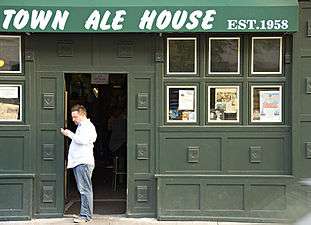
 A building in Old Town built in the 1920s
A building in Old Town built in the 1920s Loews Theater at Pipers Alley (closed 2012, now houses UP Comedy Club)
Loews Theater at Pipers Alley (closed 2012, now houses UP Comedy Club) Home of a 19th-century network engineer
Home of a 19th-century network engineer The Midwest Buddhist Temple with St. Michael's visible in the upper right
The Midwest Buddhist Temple with St. Michael's visible in the upper right
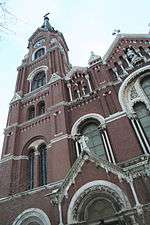
- The sign outside the Old Town Aquarium
 a building in Old Town
a building in Old Town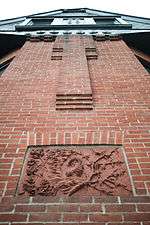 Details of a building in Old Town
Details of a building in Old Town- Burton Place, on the left, other buildings on the center and right
- Rowhouses on Lincoln Avenue
See also
References
- ↑ National Park Service (2007-01-23). "National Register Information System". National Register of Historic Places. National Park Service.
- 1 2 "Old Town". tribunedigital-chicagotribune. 29 March 2008. Retrieved 26 March 2015.
- 1 2 "Old Town: Gold Rush in a Cabbage Patch (December 4, 1967)". Chicago Tribune.
- 1 2 Baugher, Shirley (2011). Hidden History of Old Town. Charleston, SC: The History Press. p. 29. ISBN 978-1-60949-207-6.
- 1 2 "Old Town: Gold Rush in a Cabbage Patch (December 4, 1967)". Chicago Tribune. Retrieved 2015-06-16.
- ↑ "EXPECT CROWD OF 40,000 FOR OLD TOWN FAIR (May 29, 1960)". Chicago Tribune.
- ↑ http://www.encyclopedia.chicagohistory.org/pages/927.html
- 1 2 Atcheson, Richard: "The Spirit of Old Town", page 67. Holiday Magazine, The Curtis Publishing Company, March 1967
- ↑ "Native Americans". Encyclopedia of Chicago. Chicago Historical Society. 2005. Retrieved 31 August 2009.
- ↑ "Chicago Landmarks – Old Town Triangle District". City of Chicago Department of Planning and Development, Landmarks Division. 2003. Retrieved 31 August 2009.
- ↑ "Henry Gerber House". City of Chicago Department of Planning and Development, Landmarks Division. 2003. Retrieved 2007-06-27.
- ↑ Sun-Times (2015-06-19). "Old Town site of nation's first gay rights group designated national landmark | Chicago". Chicago.suntimes.com. Retrieved 2015-06-28.
- ↑ "Hidden History of Old Town". google.com.
- ↑ Sean Parnell. "De Luxe Gardens in Memoriam: Chicago Bar Project". chibarproject.com.
- ↑ "To Serve and Collect". google.com.
- ↑ Chicago Tribune. "Alderman Mathias". chicagotribune.com.
- ↑ "LIFE". google.com.
- ↑ http://www.encyclopedia.chicagohistory.org/pages/527.html
- ↑ http://archives.chicagotribune.com/1968/08/27/page/5/article/police-rout-hippies-with-gas-charge
- ↑ "Testimony of Abbie Hoffman in the Chicago Seven Trial". umkc.edu.
- ↑ "History - Old Town School of Folk Music". oldtownschool.org. Retrieved 26 March 2015.
- ↑ "On the Town (December 21, 1969)". Chicago Tribune.
- ↑ "Remembering Earl Pionke". Chicago Tonight - WTTW. Retrieved 26 March 2015.
- ↑ http://www.encyclopedia.chicagohistory.org/pages/511.html
- ↑ https://books.google.com/books?id=gVuwpbljQ2oC&pg=PA77&lpg=PA77&dq=wells+street+porn&source=bl&ots=ZRoPzuCVF6&sig=LEdmsFVP8jIadTjdWeQ-Nwt_wBg&hl=en&sa=X&ved=0CDUQ6AEwBTgKahUKEwjEo8SEk5vHAhVJdj4KHa5HCJc#v=onepage&q=wells%20street%20porn&f=false
- ↑ "The Porno Plague". Time Magazine. 5 April 1976. Retrieved 26 October 2010.
- ↑ "Suspected Porn Boss Dies In His Apartment". Chicago Tribune. 7 October 1988.
- ↑ Old Town Triangle Association / Old Town Art Fair
- ↑ "Raising the Roof Gives New Life to Old Coach House (January 22, 1967)". Chicago Tribune.
External links
| Wikimedia Commons has media related to Old Town, Chicago. |
| Wikivoyage has a travel guide for Old Town (Chicago). |
- Old Town Triangle Association
- Photos of Old Town
- Chicago Traveler
- Old Town Merchants and Residents Association
- City Of Chicago landmark of Old Town
- Chicago Reader article about Old Town and gentrification
Coordinates: 41°54′40″N 87°38′22″W / 41.9111°N 87.6395°W